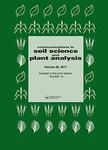版权所有:内蒙古大学图书馆 技术提供:维普资讯• 智图
内蒙古自治区呼和浩特市赛罕区大学西街235号 邮编: 010021

作者机构:ICAR Natl Bur Soil Survey & Land Use Planning Nagpur 440033 India ICAR Natl Bur Soil Survey & Land Use Planning Reg Ctr Udaipur India ICAR Natl Bur Soil Survey & Land Use Planning Reg Ctr New Delhi India ICAR Natl Bur Soil Survey & Land Use Planning Reg Ctr Jorhat India
出 版 物:《COMMUNICATIONS IN SOIL SCIENCE AND PLANT ANALYSIS》 (Commun. Soil Sci. Plant Anal.)
年 卷 期:2025年第56卷第7期
页 面:1106-1131页
核心收录:
学科分类:0710[理学-生物学] 09[农学] 0903[农学-农业资源与环境] 0901[农学-作物学] 0703[理学-化学]
基 金:ICAR-National Bureau of Soil Survey and Land Use Planning ICAR-National Bureau of Soil Survey and Land Use Planning Nagpur, Maharashtra, India Regional Centre, Udaipur and Nagpur
主 题:Digital soil mapping machine learning algorithms Rajasthan and Gujarat soil depth
摘 要:Soil depth is essential for eco-hydrological modeling, carbon storage estimation, and land evaluation, yet its spatial variation is often poorly understood and rarely mapped, particularly in complex landscapes with limited sample sizes. Digital soil mapping, employing various machine learning methods, has become crucial in predicting and mapping soil attributes. This study investigates soil depth distribution in Rajasthan and Gujarat, India, using machine learning techniques. A total of 37 environmental variables were examined to identify factors influencing soil depth, utilizing data from 3206 soil profiles. Five machine learning algorithms - Random Forest (RF), Cubist, Support Vector Machines (SVM), extreme gradient boosting (XGBoost), and Partial Least Squares Regression (PLSR) - were evaluated. MODIS, WorldClim, and Digital Elevation Model were used as environmental covariates. Among these, channel network base level, and valley depth were found to be the most significant factors in soil depth modeling. The RF model produced the best results, with an R2 of 0.53, RMSE of 25.19 cm, and MAE of 16.04 cm, outperforming Cubist and other models. Predicted soil depths ranged from 23 to 197 cm in Rajasthan and from 16 to 182 cm in Gujarat. The spatial pattern of soil depth closely matched expectations for the studied regions, demonstrating effective model and variable selection. However, uncertainty assessment revealed significant uncertainty in 60% of the study area due to low soil profile points. This study presents a promising approach to predict soil depth via digital mapping, aiding regional land use planning and potentially informing national and international land resource management strategies.